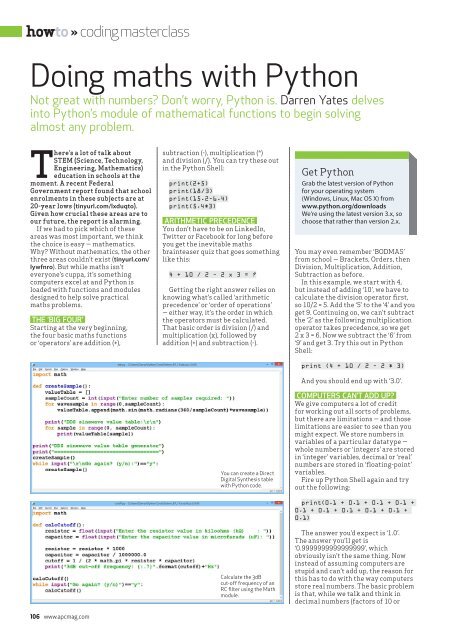Create successful ePaper yourself
Turn your PDF publications into a flip-book with our unique Google optimized e-Paper software.
howto » coding masterclass<br />
Doing maths with Python<br />
Not great with numbers? Don’t worry, Python is. Darren Yates delves<br />
into Python’s module of mathematical functions to begin solving<br />
almost any problem.<br />
There’s a lot of talk about<br />
STEM (Science, Technology,<br />
Engineering, Mathematics)<br />
education in schools at the<br />
moment. A recent Federal<br />
Government report found that school<br />
enrolments in these subjects are at<br />
20-year lows (tinyurl.com/lxduqto).<br />
Given how crucial these areas are to<br />
our future, the report is alarming.<br />
If we had to pick which of these<br />
areas was most important, we think<br />
the choice is easy — mathematics.<br />
Why? Without mathematics, the other<br />
three areas couldn’t exist (tinyurl.com/<br />
lywfnro). But while maths isn’t<br />
everyone’s cuppa, it’s something<br />
computers excel at and Python is<br />
loaded with functions and modules<br />
designed to help solve practical<br />
maths problems.<br />
THE ‘BIG FOUR’<br />
Starting at the very beginning,<br />
the four basic maths functions<br />
or ‘operators’ are addition (+),<br />
subtraction (-), multiplication (*)<br />
and division (/). You can try these out<br />
in the Python Shell:<br />
print(2+5)<br />
print(18/3)<br />
print(15.2-6.4)<br />
print(5.4*3)<br />
ARITHMETIC PRECEDENCE<br />
You don’t have to be on LinkedIn,<br />
Twitter or Facebook for long before<br />
you get the inevitable maths<br />
brainteaser quiz that goes something<br />
like this:<br />
4 + 10 / 2 – 2 x 3 = ?<br />
Getting the right answer relies on<br />
knowing what’s called ‘arithmetic<br />
precedence’ or ‘order of operations’<br />
— either way, it’s the order in which<br />
the operators must be calculated.<br />
That basic order is division (/) and<br />
multiplication (x), followed by<br />
addition (+) and subtraction (-).<br />
You can create a Direct<br />
Digital Synthesis table<br />
with Python code.<br />
Get Python<br />
Grab the latest version of Python<br />
for your operating system<br />
(Windows, Linux, Mac OS X) from<br />
www.python.org/downloads<br />
We’re using the latest version 3.x, so<br />
choose that rather than version 2.x.<br />
You may even remember ‘BODMAS’<br />
from school — Brackets, Orders, then<br />
Division, Multiplication, Addition,<br />
Subtraction as before.<br />
In this example, we start with 4,<br />
but instead of adding ‘10’, we have to<br />
calculate the division operator first,<br />
so 10/2 = 5. Add the ‘5’ to the ‘4’ and you<br />
get 9. Continuing on, we can’t subtract<br />
the ‘2’ as the following multiplication<br />
operator takes precedence, so we get<br />
2 x 3 = 6. Now we subtract the ‘6’ from<br />
‘9’ and get 3. Try this out in Python<br />
Shell:<br />
print (4 + 10 / 2 – 2 * 3)<br />
And you should end up with ‘3.0’.<br />
COMPUTERS CAN’T ADD UP?<br />
We give computers a lot of credit<br />
for working out all sorts of problems,<br />
but there are limitations — and those<br />
limitations are easier to see than you<br />
might expect. We store numbers in<br />
variables of a particular datatype —<br />
whole numbers or ‘integers’ are stored<br />
in ‘integer’ variables, decimal or ‘real’<br />
numbers are stored in ‘floating-point’<br />
variables.<br />
Fire up Python Shell again and try<br />
out the following:<br />
106 www.apcmag.com<br />
Calculate the 3dB<br />
cut-off frequency of an<br />
RC filter using the Math<br />
module.<br />
print(0.1 + 0.1 + 0.1 + 0.1 +<br />
0.1 + 0.1 + 0.1 + 0.1 + 0.1 +<br />
0.1)<br />
The answer you’d expect is ‘1.0’.<br />
The answer you’ll get is<br />
‘0.9999999999999999’, which<br />
obviously isn’t the same thing. Now<br />
instead of assuming computers are<br />
stupid and can’t add up, the reason for<br />
this has to do with the way computers<br />
store real numbers. The basic problem<br />
is that, while we talk and think in<br />
decimal numbers (factors of 10 or


















